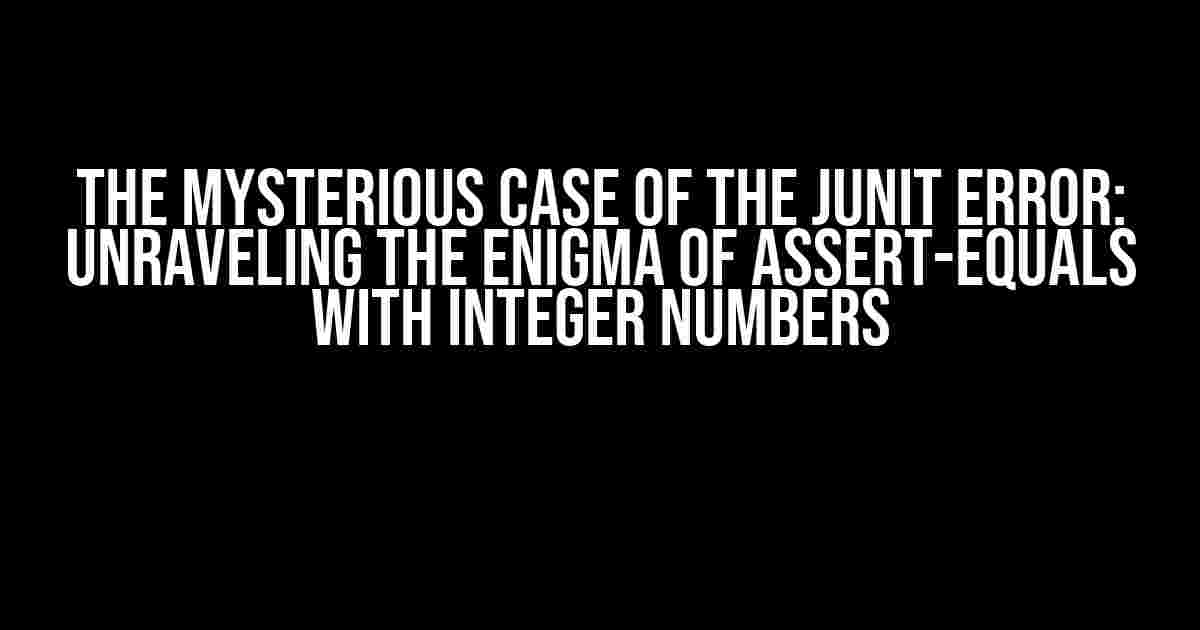As a developer, you’ve likely encountered the frustration of staring at a JUnit test that refuses to pass, despite your best efforts. The error message taunts you, saying that your assert-equals statement is failing, even though you’re comparing two integer numbers that should be equal. What’s going on? Fear not, dear coder, for we’re about to embark on a thrilling adventure to uncover the truth behind this mystifying issue.
The Scene of the Crime: Understanding assert-equals
Before we dive into the solution, let’s take a step back and review the basics. assert-equals is a fundamental method in JUnit that checks whether two values are equal. It’s a crucial tool in your testing arsenal, helping you verify that your code behaves as expected. The syntax is simple:
ASSERT.assertEquals(expected, actual);
In this example, expected is the value you anticipate, and actual is the result produced by your code. When the two values match, the test passes; otherwise, it fails. Easy peasy, right?
The Plot Thickens: The Error Message
Now, let’s examine the error message that’s got you stumped:
java.lang.AssertionError: expected:<integer value> but was:<integer value>
This message indicates that the expected and actual values are not equal, but you’re convinced that they should be. You’ve double-checked your code, and the math adds up. What’s going on?
The Usual Suspects: Common Causes of the Error
Before we get to the root of the problem, let’s rule out some common culprits:
- Typo in the code: Double-check your code for any typos or mismatched variable names.
- Data type mismatch: Ensure that both values are of the same data type (in this case, integers).
- Null pointer exception: Verify that neither the expected nor actual values are null.
- Unintended implicit conversion: Be aware of any implicit conversions that might affect the comparison.
If you’ve checked all these boxes and the error persists, it’s time to dig deeper.
The Real Culprit: Understanding Integer Overflow
The root cause of the issue lies in the way Java handles integer arithmetic. When you perform operations on integers, Java uses the int data type, which has a limited range (-2,147,483,648 to 2,147,483,647). If the result of your operation exceeds this range, an integer overflow occurs.
In the context of your JUnit test, this means that even if your math is correct, the expected and actual values might not be equal due to integer overflow.
The Smoking Gun: Identifying Integer Overflow
To determine if integer overflow is the culprit, you’ll need to inspect your code and identify any potential overflow scenarios. Ask yourself:
- Are you performing any multiplications or divisions that could result in a value exceeding the integer range?
- Are you using any libraries or frameworks that might be prone to integer overflow?
- Are there any potential edge cases that could cause an overflow?
If you suspect integer overflow, it’s time to take action.
The Solution: Mitigating Integer Overflow
To avoid integer overflow and ensure that your assert-equals statement succeeds, you have a few options:
Option 1: Use Long Data Types
One solution is to use the long data type, which has a much larger range (-9,223,372,036,854,775,808 to 9,223,372,036,854,775,807). This is particularly useful when working with large numbers or performing operations that are prone to overflow.
ASSERT.assertEquals(expectedLong, actualLong);
Option 2: Use BigInteger
If you’re working with extremely large numbers or need precise control over arithmetic operations, consider using the BigInteger class. This class provides arbitrary-precision integers, ensuring that your calculations are accurate and overflow-free.
ASSERT.assertEquals(expectedBigInt, actualBigInt);
Option 3: Refactor Your Code
In some cases, you might need to rethink your algorithm or approach to avoid integer overflow altogether. This could involve breaking down complex operations into smaller, more manageable pieces or using alternative data structures.
| Option | Description | Example |
|---|---|---|
| Use Long Data Types | Use long instead of int to increase the range of values. |
long expectedLong = 1000000; |
| Use BigInteger | Use BigInteger for arbitrary-precision integers. |
BigInteger expectedBigInt = new BigInteger("1000000"); |
| Refactor Your Code | Re-engineer your algorithm to avoid integer overflow. | int sum = 0; for (int i = 0; i < 1000000; i++) { sum += i; } |
By applying one of these solutions, you should be able to resolve the issue and get your JUnit test passing.
The Grand Finale: Putting it all Together
Now that we’ve explored the possible causes and solutions, let’s summarize the steps to overcome the assert-equals error with integer numbers:
- Verify that your code is free of typos, data type mismatches, and null pointer exceptions.
- Identify potential scenarios where integer overflow might occur.
- Choose a solution to mitigate integer overflow, such as using long data types, BigInteger, or refactoring your code.
- Implement the chosen solution and adjust your assert-equals statement accordingly.
- Run your JUnit test again, and with a bit of luck, it should pass!
By following these steps and understanding the intricacies of integer arithmetic in Java, you’ll be well-equipped to tackle similar issues and write more robust, reliable code.
And there you have it, folks! The mystery of the JUnit error has been solved, and your code can now shine with confidence. Remember, in the world of coding, even the most seemingly insignificant issues can hold the key to unlocking a deeper understanding of the language.
Frequently Asked Question
Encountering an error in JUnit program despite using assert-equals with two integer numbers? Don’t worry, we’ve got you covered!
Why is my JUnit test failing even though I’m using assert-equals with two integer numbers?
It’s possible that the integers you’re comparing are not exactly equal due to rounding errors or other numerical issues. Try using assertEquals with a delta value to specify an acceptable margin of error.
Is it possible that the error is due to the order of the parameters in assert-equals?
Yes, that’s a great point! Make sure you’re passing the expected value first, followed by the actual value. The correct order is assertEquals(expected, actual). Swapping them can lead to unexpected results.
Could the error be related to the type of integers I’m using?
That’s a good question! Ensure that you’re using the correct type of integers (e.g., int, long, Integer, Long) and that they match the types of the variables being compared. Mismatched types can cause assert-equals to fail unexpectedly.
Is there a possibility that the error is coming from somewhere else in my code?
Absolutely! Don’t assume the error is always in the assert-equals statement. Look for other potential issues in your code, such as incorrect logic, uninitialized variables, or unexpected exceptions. Use a debugger or add more logging statements to help identify the root cause.
What if I’ve checked everything and the error still persists?
Time to get creative! Try simplifying your test case, breaking it down into smaller parts, or even rewriting the test from scratch. Sometimes, taking a fresh look or approaching the problem from a different angle can help you identify the issue. Don’t be afraid to ask for help or seek advice from a colleague or online community.



